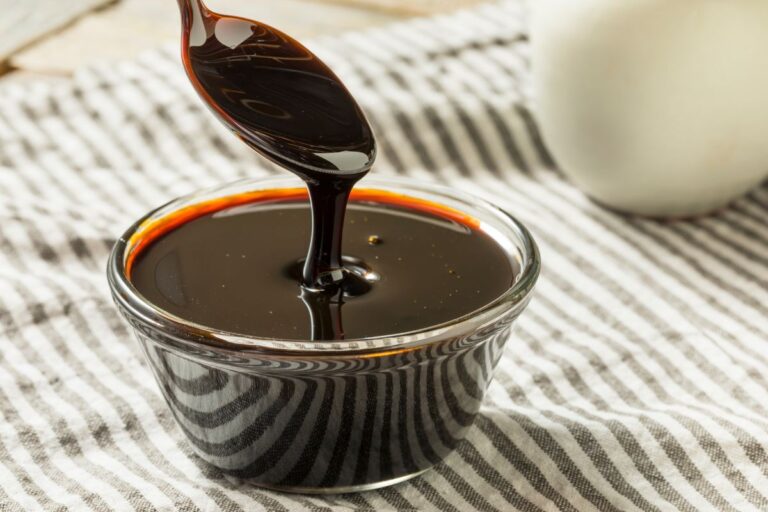Molasses is a thick, dark, and sweet liquid that is made from boiling down sugar cane or beet juice. It is a natural and nutritious sweetener that can be used in baking, cooking, or as a spread. But how do you store molasses properly to keep it fresh and tasty? Do you need to refrigerate it or not?
The short answer is: No, you don’t need to refrigerate molasses.
In fact, refrigerating molasses can make it harder to use, as it can make it thicker and lighter, and take up space in your fridge. The best place to store molasses is in the pantry, in a cool, dry, and dark place, away from heat, light, and moisture sources.
According to Crosby Foods:
Molasses is best kept at room temperature between 10°C to 21°C (50 – 70°F). The shelf life of molasses is generally 18 months when kept below 21°C and under reasonably steady conditions of temperature and humidity. Refrigeration or freezing may crystallize the natural sugars and therefore is not recommended.
However, there is more to storing molasses than just choosing the right place. You also need to choose the right container, the right method, and the right time for storing your molasses. Here are some tips and guidelines on how to store molasses properly and make it last longer and taste better. You may also be wondering, does molasses go bad?
Choosing the Right Container for Molasses Storage
The container you use to store your molasses can affect its shelf life and quality. You need to use a container that can prevent air, moisture, and light from entering your molasses, and that can protect your molasses from contamination, spoilage, or leakage. The best containers for storing molasses are:
- Glass jars: Glass jars are the ideal containers for storing molasses, as they are airtight, transparent, and easy to clean. Glass jars can prevent air, moisture, and light from entering your molasses, and allow you to see the color and consistency of your product. Glass jars are also reusable and eco-friendly, and can be sterilized by boiling or baking.
- Plastic containers: Plastic containers are another option for storing molasses, as they are lightweight, durable, and inexpensive. Plastic containers can also prevent air and moisture from entering your molasses, but they may not be as effective as glass jars in blocking light. Plastic containers are also prone to staining, cracking, or leaching chemicals into your molasses, especially if they are not food-grade or BPA-free. Plastic containers are also not as easy to clean or sterilize as glass jars, and may retain odors or flavors from previous contents.
You should avoid using metal containers for storing molasses, as they can react with the acids and sugars in your molasses, causing corrosion, discoloration, or metallic taste. Metal containers can also conduct heat, which can affect the temperature and viscosity of your molasses. Metal containers are also not transparent, which can make it hard to see the condition of your molasses.
You should also use a lid that can seal and close your molasses container tightly and securely, to prevent air and moisture from entering your molasses. The best lids for storing molasses are screw-on lids, as they can create a tight and secure fit that can prevent air and moisture from entering your molasses. Screw-on lids are also easy to open and close, and can be reused or replaced as needed. Screw-on lids are available for both glass and plastic containers, and can be made of metal, plastic, or rubber.
Choosing the Right Method for Storing Molasses
The method you use to store your molasses can affect its shelf life and quality. You need to use a method that can preserve the flavor and freshness of your molasses, and that can suit your needs and preferences. The best methods for storing molasses are:
- Storing in the pantry: Storing in the pantry is the best method for storing molasses, as it can provide a cool, dry, and dark environment that can protect your molasses from the factors that can affect its shelf life and quality. When storing your molasses in the pantry, you should choose a shelf that is away from heat and light sources, such as stoves, ovens, windows, lamps, or fluorescent lights. You should also avoid storing your molasses in places that can experience temperature fluctuations, such as near doors, vents, or pipes. You should also protect your molasses from light exposure, by covering your molasses containers with a cloth, a paper bag, or a cardboard box, or by using opaque or colored containers, such as amber or blue glass jars, or dark plastic containers.
- Refrigerating: Refrigerating is another method for storing molasses, but it is not necessary or recommended. Refrigerating molasses can extend its shelf life, but it can also make it harder to use, as it can make it thicker and lighter, and take up space in your fridge. Refrigerating molasses can also make it milder, as it can reduce the color and flavor of your molasses. Refrigerating molasses can also expose it to other odors or flavors in your fridge, which can affect the taste and quality of your molasses. If you decide to refrigerate your molasses, you should use a proper temperature, between 35°F and 40°F (2°C and 4°C), and prevent flavor absorption, by sealing and closing your molasses containers tightly and securely, and by wrapping them with plastic wrap, aluminum foil, or wax paper, or placing them in a ziplock bag or an airtight container.
- Freezing: Freezing is another method for storing molasses, but it is also not necessary or recommended. Freezing molasses can extend its shelf life, but it can also change its texture and taste, as it can cause crystallization, separation, or dilution of your molasses. Freezing molasses can also make it harder to use, as you will need to thaw and stir your molasses before using it. If you decide to freeze your molasses, you should use ice cube trays, as they can allow you to freeze your molasses in small and convenient portions that you can easily pop out and use. You should also label and date your molasses containers to keep track of their freshness.
Choosing the Right Time for Storing Molasses
The time you store your molasses can affect its shelf life and quality. You need to store your molasses within the recommended shelf life, or discard it if it has gone bad. The shelf life of molasses depends on several factors, such as the type, brand, and quality of the product, and how you store it. Generally, unopened molasses can last for about two years, while opened molasses can last for about one year. However, these are only approximate estimates, and the actual shelf life of your molasses may be shorter or longer depending on how you store it.
You can tell if your molasses has gone bad by looking for signs of spoilage, such as mold, off odors, or flavors, or changes in color, texture, or appearance. If you see any of these signs, you should discard your molasses and clean and sanitize your container and utensils.
Conclusion
Molasses is a delicious and nutritious sweetener that can be used in many ways, but it can also lose its quality and freshness over time. Therefore, it is important to know how to store molasses properly to preserve its flavor and shelf life. The main points to remember are:
- You don’t need to refrigerate molasses. The best place to store molasses is in the pantry, in a cool, dry, and dark place, away from heat, light, and moisture sources.
- The best containers to store molasses are glass jars with screw-on lids, as they are airtight, transparent, and easy to clean. Plastic containers with snap-on lids are another option, but they may not be as effective or durable. Metal containers are not recommended, as they can react with molasses and cause corrosion, discoloration, or metallic taste.
- The best methods for storing molasses are storing in the pantry, refrigerating, or freezing, depending on your needs and preferences. Storing in the pantry is the best method, as it can provide a cool, dry, and dark environment that can protect your molasses from the factors that can affect its shelf life and quality. Refrigerating or freezing molasses can extend its shelf life, but it can also make it harder to use, as it can make it thicker, lighter, and milder, and take up space in your fridge or freezer.
- The best time to store molasses is within the recommended shelf life, or discard it if it has gone bad. The shelf life of molasses depends on the type, brand, and quality of the product, and how you store it. Generally, unopened molasses can last for about two years, while opened molasses can last for about one year. You can tell if your molasses has gone bad by looking for signs of spoilage, such as mold, off odors, or flavors, or changes in color, texture, or appearance.
Further Reading
Should Mustard Be Refrigerated?
Should Soy Sauce Be Refrigerated?
Should Honey Be Refrigerated?
Does Fish Sauce Need to Be Refrigerated?
Should Worcestershire Sauce Be Refrigerated?
Better Living uses affiliate links. If you make a purchase through them, we may receive a small commission (for which we are deeply grateful) at no cost to you.



